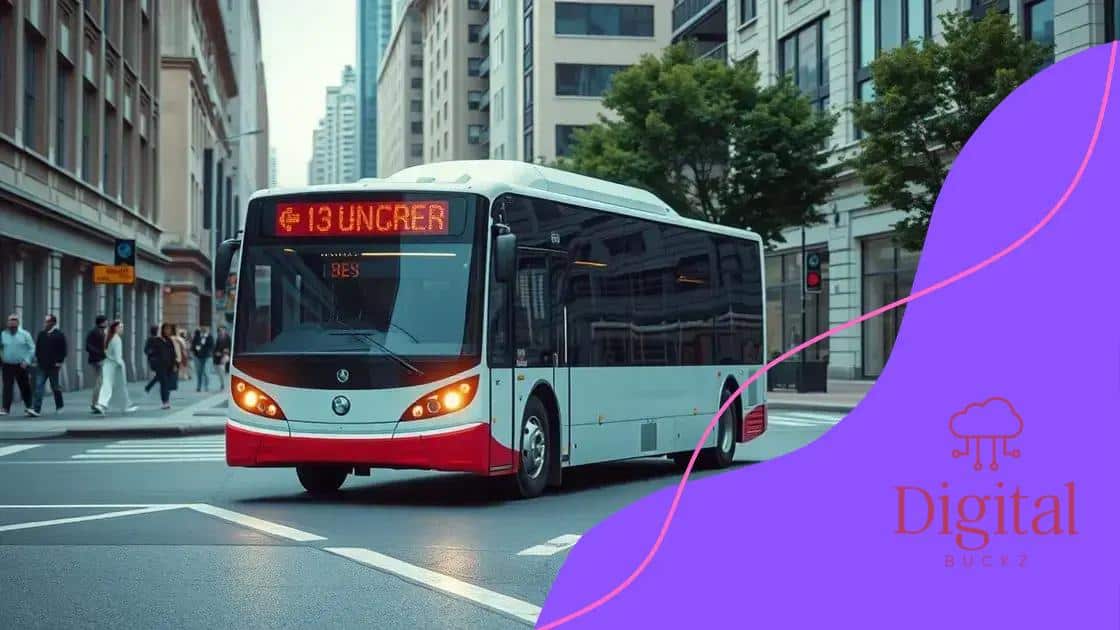How autonomous vehicles are influencing public transport

Autonomous vehicles are transforming public transport by enhancing safety, improving efficiency, and contributing to environmental sustainability through reduced emissions and optimized traffic management.
How autonomous vehicles are influencing public transport is a topic that sparks numerous discussions. Imagine hopping on a bus that drives itself—fascinating, right? Let’s dive into how this technology is reshaping our commuting experiences.
Defining autonomous vehicles and their technology
Understanding autonomous vehicles is essential to grasp how they are changing public transport. These vehicles operate without human intervention, using a blend of sensors, cameras, and artificial intelligence. They analyze data from their surroundings to navigate safely.
Key Technologies Behind Autonomous Vehicles
The technology that powers these vehicles is fascinating. It consists of various components working together to create a fully autonomous experience.
- Sensors: Detect objects, obstacles, and road conditions.
- Computer Vision: Processes images from cameras to understand surroundings.
- Machine Learning: Allows vehicles to improve performance and decision-making over time.
Another important aspect is the communication systems. Autonomous vehicles often use vehicle-to-vehicle (V2V) and vehicle-to-infrastructure (V2I) communication to share information with other vehicles and road systems. This increases safety and efficiency on the roads.
These innovations lead to a level of safety that can potentially reduce accidents caused by human error. As technology advances, the vision for fully autonomous public transport systems becomes more achievable.
Challenges in Autonomous Vehicle Technology
While the benefits are numerous, there are challenges to overcome in developing autonomous vehicles. These include legal regulations, technology reliability, and public trust. The legal framework is still adapting to include these advanced technologies, making it crucial for lawmakers to stay updated.
The technology itself must also address various scenarios and conditions that could impact a safe ride. For instance, adverse weather can complicate a vehicle’s perception of its surroundings, and testing in these conditions remains essential. As we navigate this changing landscape, the potential of autonomous vehicles continues to excite and inspire innovation.
Current examples of autonomous public transport
In recent years, several cities have begun to implement autonomous public transport systems. These examples showcase how technology can improve urban mobility and enhance the commuting experience.
Notable Examples of Autonomous Public Transport
Many cities around the world are testing or using autonomous vehicles for public transport. These initiatives highlight the potential benefits and efficiencies of self-driving technology.
- Waymo One: Operating in Phoenix, Arizona, Waymo offers a fully autonomous ride-hailing service.
- Navya shuttles: Used in various locations, including Las Vegas and France, these shuttles provide driverless transportation for short distances.
- Gatik: This company focuses on autonomous delivery trucks. Their technology is currently being tested in various urban settings.
These projects demonstrate the broad applications of autonomous technology. In addition to enhancing convenience, they can help reduce congestion by optimizing routes and minimizing idle time.
Moreover, cities like San Francisco and Amsterdam are exploring partnerships to develop autonomous buses. These projects aim to create a seamless public transport experience while addressing the challenges of urban populations.
Benefits of Autonomous Public Transport
The shift to autonomous public transport can lead to several significant advantages. Reducing traffic accidents caused by human error is a primary benefit. Furthermore, with fewer drivers needed, operational costs may decrease, leading to lower fares for passengers.
Environmental impacts are also noteworthy. Many autonomous public transport systems are moving toward electric vehicles, which can help decrease emissions and promote sustainability in urban areas. As technology progresses, we can expect that the integration of these systems will enhance the overall quality of life in cities.
Benefits of integrating autonomous vehicles

Integrating autonomous vehicles into public transport offers various benefits that can transform urban mobility. These advantages extend beyond convenience and efficiency, significantly impacting safety and the environment.
Safety Improvements
One of the most significant benefits of using autonomous vehicles is the potential for improved safety. By removing human error, which causes the majority of traffic accidents, we can create safer roads. Autonomous technology utilizes advanced sensors and algorithms to monitor surroundings and make split-second decisions.
- Real-time data processing: Autonomous vehicles can analyze data much faster than humans.
- Predictive analysis: They can foresee potential hazards from other vehicles or pedestrians.
- 24/7 operation: These vehicles can safely operate at all times without fatigue or distraction.
With these enhancements, cities can significantly reduce injury and fatality rates on the roads.
Environmental Benefits
Another vital aspect of integrating autonomous vehicles is their potential to positively affect the environment. Many autonomous systems are electric or hybrid, which helps to lower overall emissions in urban areas.
Additionally, autonomous vehicles can optimize routes based on traffic conditions, leading to less time spent idling and reduced fuel consumption. This efficiency can help improve air quality and contribute to a greener city.
Cost Efficiency
Adopting autonomous public transport systems may also lead to decreased operational costs. With fewer human drivers, cities can reduce labor costs significantly. Furthermore, these vehicles can minimize the expenses related to accidents and maintenance caused by human error.
By improving public transport efficiency, cities can provide better service at lower costs, making it more attractive for residents to utilize these systems.
In summary, the benefits of integrating autonomous vehicles into public transport are numerous, from enhancing safety and reducing environmental impact to cutting costs. As technology continues to advance, these advantages will likely become even more pronounced.
Challenges faced in implementation
Implementing autonomous vehicles in public transport comes with various challenges that cities must address. These challenges can affect how quickly and effectively this technology is adopted.
Regulatory Hurdles
One of the main challenges is the need for updated regulations. Laws regarding vehicle operation, safety standards, and insurance need to be revised to accommodate autonomous technology. Many cities are still working to create a legal framework that supports the safe implementation of these vehicles.
- Establishing safety standards: Proper safety regulations must be determined.
- Liability issues: Who is responsible for accidents involving autonomous vehicles?
- Testing approvals: Cities need processes for approving testing in public spaces.
These regulatory hurdles can slow down the deployment of autonomous systems and require collaboration between public and private sectors.
Public Perception and Trust
Another significant challenge is building public trust. People are often skeptical about the safety of autonomous vehicles. Misconceptions and fears about technology can hinder acceptance.
Creating awareness programs and demonstrations can help educate the public on how these vehicles operate safely. As more people see the technology in action, their concerns may lessen.
Technical Limitations
The technology itself also faces limitations. Autonomous vehicles rely on sensors and software that must function flawlessly in various conditions. Weather extremes, such as heavy rain or snow, can affect sensor performance.
Moreover, ensuring accurate navigation in complex urban environments poses challenges due to unpredictable human behavior and diverse road conditions.
Addressing these technical limitations is crucial to the successful integration of autonomous vehicles within public transport systems.
Collectively, these challenges present significant hurdles for the widespread adoption of autonomous vehicles in public transport. However, overcoming these obstacles is necessary for harnessing the full potential of this transformative technology.
The future of public transport with autonomous vehicles
The future of public transport with autonomous vehicles holds exciting possibilities for cities and their residents. As technology progresses, we can envision a transformative shift in how public transport operates.
Seamless Integration
One key aspect of this future is the seamless integration of autonomous vehicles into existing public transport systems. Creating a network where buses, shuttles, and ride-sharing services work together can enhance user experience. Imagine a scenario where commuters use a single app to plan their journey across multiple modes of transport.
- Unified payment systems: Passengers could pay for all services in one go.
- Real-time updates: Users will receive live notifications about vehicle arrivals and delays.
- Enhanced connectivity: Autonomous vehicles can fill gaps in public transport coverage, especially in underserved areas.
This interconnectedness would make public transport more efficient and user-friendly.
Environmental Impact
Another promising aspect is the potential positive environmental impact. Autonomous vehicles are often electric, leading to less pollution in urban areas. This shift toward greener technology can contribute to cities meeting ambitious sustainability goals.
Among the benefits, less congestion can lead to shorter travel times and improved air quality. With more people using public transport, cities can also reduce reliance on personal vehicles, fostering an eco-friendly environment.
Urban Planning and Design
The rise of autonomous public transport will influence urban planning and infrastructure. Cities may redesign streets and transit hubs to accommodate self-driving vehicles and their unique needs. This change could lead to safer road designs, more green spaces, and a focus on pedestrian-friendly areas.
As autonomous vehicles become more common, they have the potential to improve overall accessibility for everyone, including individuals with disabilities. Adaptive vehicles can cater to those who need extra assistance, making public transport a viable option for all.
In summary, the future of public transport with autonomous vehicles looks bright. The many possible advancements can lead to improved efficiency, environmental sustainability, and overall quality of life for urban residents.
FAQ – Frequently Asked Questions about Autonomous Vehicles in Public Transport
What are autonomous vehicles?
Autonomous vehicles are self-driving cars or shuttles that can navigate and operate without human intervention, using advanced sensors and software.
How will autonomous vehicles improve public transport?
They will enhance safety, reduce traffic congestion, and provide more efficient service to riders, making public transport more accessible.
Are there any challenges in implementing autonomous vehicles?
Yes, challenges include regulatory hurdles, public perception, technical limitations, and the need for significant infrastructure changes.
What environmental benefits do autonomous vehicles offer?
These vehicles often use electric technology, leading to lower emissions and contributing to a greener urban environment.






